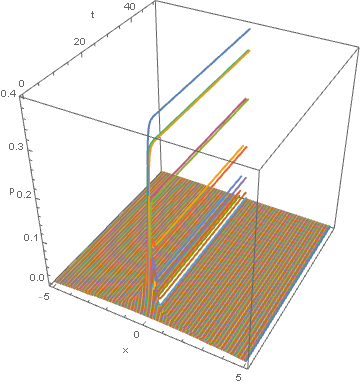I have the next system of ODEs: $$ \frac{1}{2}\sigma^2 p''_n(x)+x p'_n(x)+p_n(x)-\frac{p_n(x)-p_{n-1}(x)}{\Delta t}=0,$$ $$p_1(a)=p(b)=0;\quad p_0(x)=0.1,\quad n=1.\dots N, $$ which was derived from the elliptic pde by method of lines: $$\frac{\partial p}{\partial t}=p+x\frac{\partial p}{\partial x}+\frac{1}{2}\sigma^2\frac{\partial^2 p}{\partial x^2},$$ $$lim_{x\rightarrow\pm \infty} p(x,t)=0,\quad \forall t.$$ Now I should set the border values: $a$ and $b.$ I want them to be as far from zero as possible. But the problem arises when I try to solve the system by method of shooting, that doesn't permit me to set them different from $a=0$, $b=1$.
n = 5;
h = 1/n;
U[x_] = Table[Subscript[u, i][x], {i, 0, n}] /.
Subscript[u, 0][x] -> g[x];
Eq = Table[Subscript[eq, i], {i, 0, n}];
\[Sigma] = 0.1;
a[x_, t_] = 1/2 \[Sigma]^2;
b[x_, t_] = x;
c[x_, t_] = -1;
d[x_, t_] = 1;
f[x_, t_] = 0;
g[x_] = 0.1;
\[Alpha][t_] = 0;
\[Beta][t_] = 0;
xl = -0.5;
xr = 0.5;
A=0;
B=1;
eqs = Table[Eq[[i]] = 1/(xr - xl)^2 a[x, h i ] D[U[x][[i]], {x, 2}] + 1/(xr - xl) b[x, h i ] D[U[x][[i]], x] - c[x, h i ] U[x][[i]] - d[x, h i ] ((U[x][[i]] - U[x][[i - 1]])/h) - f[x, h i ] == 0, {i, 2, n + 1}];
bcs = Table[{U[A][[i]] == 0, U[B][[i]] == 0}, {i, 2, n + 1}]
sols = First[ NDSolve[{eqs, bcs}, U[x], x, Method -> {"Shooting",
"StartingInitialConditions" -> Table[(D[U[x][[i]], x] /. x -> 0) == 1, {i, 2, n + 1}]}]]
When I set $A=-1$ and change initial conditions for method of shooting I get the error:
NDSolve::bvluc: The equations derived from the boundary conditions are numerically ill-conditioned. The boundary conditions may not be sufficient to uniquely define a solution. If a solution is computed, it may match the boundary conditions poorly.
NDSolve::berr: The scaled boundary value residual error of 5.277001462096112`*^45 indicates that the boundary values are not satisfied to specified tolerances. Returning the best solution found.
I've also tried to rescale the system by inputing scale variables $xl$ and $xr$. But the same problem holds true. Only current values can be applied. Have no clue what's the problem can be - the analytical solution for the given pde exists uniquely.


